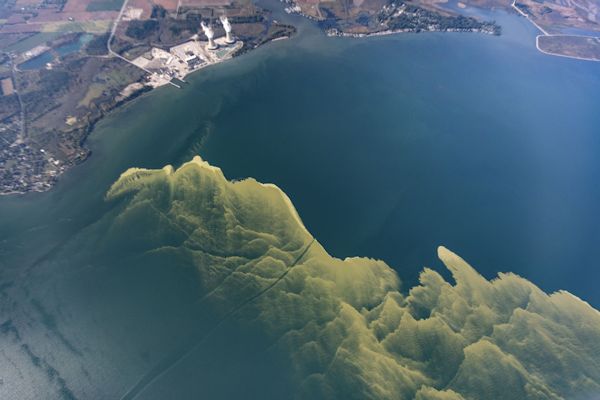SEJournal Online is the digital news magazine of the Society of Environmental Journalists. Learn more about SEJournal Online, including submission, subscription and advertising information.
 |
| Aerial image of a harmful algal bloom in the Western Basin of Lake Erie, on Sept. 25, 2017. Photo: Aerial Associates Photography, Inc. by Zachary Haslick, NOAA |
TipSheet: Great Lakes Offer Great Stories to Reporters in the Know
For the eight states that drain into them — Minnesota, Wisconsin, Michigan, Illinois, Indiana, Ohio, Pennsylvania and New York — the Great Lakes are big news, and the journalists who are ready with background and sources can do a better job of covering them.
What kind of news? Here’s a smorgasbord of developments to consider:
- Fertilizer-fueled algae blooms in Lake Erie can threaten to shut down drinking water systems for cities like Toledo.
- Fights erupt over appropriation of the precious water by industrial operations like the planned Foxconn plant in Wisconsin.
- Invasive species like zebra mussels, sea lamprey and now, possibly, the Asian carp pose ecosystem threats.
- Toxic chemicals like PCBs are still found in the water and can go up the food chain.
- Boating, sport fishing and sandy beaches offer fantastic recreation — if opportunities can be preserved.
- A rusting industrial base focused on the lakes still poses economic and environmental challenges.
Some more things to know: Fresh water is a very valuable commodity, and the Great Lakes contain more than one-fifth of the world’s total surface water. By surface area, they are the largest fresh water system in the world. The lakes supply drinking water to tens of millions of people living near them.
Not only that, but with the St. Lawrence Seaway, they open North America’s industrial and agricultural heartland to world shipping.
Think of the Great Lakes as a constellation of cities: Chicago, Milwaukee, Gary, Duluth, Thunder Bay, Green Bay, Detroit, Toledo, Cleveland, Toronto, Buffalo, Rochester, Oswego and even Montreal.
Think of it also as a drainage basin that includes surrounding agricultural regions of New York, Ohio, Illinois, Minnesota, Michigan, Indiana, Wisconsin and Pennsylvania.
Key resources for reporting Great Lakes stories
Now, with that picture in mind, here are some resources that can help as you cover the Great Lakes:
- International Joint Commission. This binational U.S.-Canadian body implements the Boundary Waters Treaty, first signed in 1909. The treaty is a mechanism for resolving disputes over shared waters, especially issues of water quantity. It covers other waters besides the Great Lakes (media contacts).
- Great Lakes Water Quality Agreement. This binational treaty was first signed in 1972, the year the modern U.S. Clean Water Act was enacted. It is implemented by various agencies of the U.S. and Canadian governments. On the U.S. side that means the U.S. Environmental Protection Agency mostly, although other agencies are involved too. Coordinating roles are also played by the Great Lakes Executive Committee and the International Joint Commission (contacts | media contacts | newsroom).
- Great Lakes Commission. The GLC was formed in 1955, initially as a compact between the eight U.S. Great Lakes states, although Canadian provinces have “associate” status on the body. It addresses both economic and environmental issues (media contact).
- EPA Great Lakes National Program Office. The GLNPO is an arm of the U.S. EPA, located in Chicago, which coordinates U.S. efforts under the Great Lakes Water Quality Agreement. It also coordinates the U.S. part of the Great Lakes Restoration Initiative. It is established under the Clean Water Act. In his budget proposals, President Trump has sought to virtually eliminate the GLNPO, but Congress has not gone along (contacts).
- NOAA Great Lakes Environmental Research Laboratory. This lab is a unit of the National Oceanic and Atmospheric Administration, based in Ann Arbor, Mich. It’s a hub of Great Lakes research that extends collaboratively to many other academic, government and private entities, often through the Cooperative Institute for Great Lakes Research (newsroom | contacts | media contacts).
- Great Lakes St. Lawrence Seaway System. The seaway links the lakes to the Atlantic via locks on the St. Lawrence River. It is managed as a binational partnership (contacts). On the U.S. side, the partner is the St. Lawrence Seaway Development Corporation within the Department of Transportation.
- Great Lakes News Outlets. Some of the news outlets that cover Great Lakes issues can help you find stories. Many of the major stories may be covered first by John Flesher of the Associated Press. Great Lakes specialist Dan Egan at the Milwaukee Journal Sentinel is definitely worth following. (He wrote the book “The Death and Life of the Great Lakes”.) Great Lakes Today and Great Lakes Echo are serious roundups of regional news. The Great Lakes Commission does a daily aggregation that is useful. Daily Great Lakes & Seaway Shipping News focuses on shipping. Do not overlook the best regional newspapers (Chicago Tribune, Milwaukee Journal Sentinel, Detroit News, Detroit Free Press, Toledo Blade, Cleveland Plain Dealer and the like).
* From the weekly news magazine SEJournal Online, Vol. 3, No. 15. Content from each new issue of SEJournal Online is available to the public via the SEJournal Online main page. Subscribe to the e-newsletter here. And see past issues of the SEJournal archived here.














 Advertisement
Advertisement 



